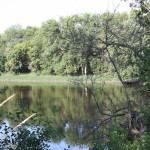I walked down the Glacial-Drumlin trail in south-central Wisconsin today to the old railroad bridge that crosses the Crawfish River. It’s a view that I’ve seen countless times over the years while training for marathons, birdwatching, or just taking a stroll. But for all the times I’ve looked at the river from that bridge, I realized today how little I have seen.
There are many ways of knowing a place. One way is to see it repeatedly over an extended period of time, observing changes from season to season and from year to year. I’ve watched the lazy water flow under the Crawfish River bridge, noticed the changing colors of massive trees along its banks. But without looking more closely, or indeed, looking elsewhere, there’s a great deal that will escape my view.
I learned that when studying the Platte River in Nebraska. Knowing that I could never match the years others had spent observing the Platte in the course of their daily lives, I set about studying it in a more systematic way – using not only time in the field, but books, maps, interviews, and museums.
Now, standing on the Crawfish River bridge, I considered all the things I would want to learn about a river before saying I knew about it. Pulling my notebook from my pocket, I began a list…and kept writing, page after page.
At home, I typed the list and attempted to organize it. What I got was a sort of syllabus for my exploration of the Baraboo and Crawfish Rivers.
It may not be necessary to make such an exhaustive study of a place in order to feel connected to it. But if you’d like to learn more about the landscape around you, my list might provide some ideas for further investigation. It will certainly provide me with an abundance of topics for future blog posts.

